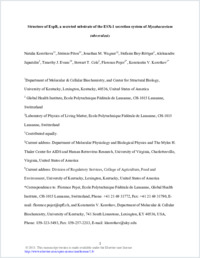Structure of EspB, a secreted substrate of the ESX-1 secretion system of Mycobacterium tuberculosis.
- Korotkova N Department of Molecular & Cellular Biochemistry, and Center for Structural Biology, University of Kentucky, Lexington, KY, 40536, United States.
- Piton J Global Health Institute, Ecole Polytechnique Fédérale de Lausanne, CH-1015 Lausanne, Switzerland.
- Wagner JM Department of Molecular & Cellular Biochemistry, and Center for Structural Biology, University of Kentucky, Lexington, KY, 40536, United States.
- Boy-Röttger S Global Health Institute, Ecole Polytechnique Fédérale de Lausanne, CH-1015 Lausanne, Switzerland.
- Japaridze A Laboratory of Physics of Living Matter, Ecole Polytechnique Fédérale de Lausanne, CH-1015 Lausanne, Switzerland.
- Evans TJ Department of Molecular & Cellular Biochemistry, and Center for Structural Biology, University of Kentucky, Lexington, KY, 40536, United States.
- Cole ST Global Health Institute, Ecole Polytechnique Fédérale de Lausanne, CH-1015 Lausanne, Switzerland.
- Pojer F Global Health Institute, Ecole Polytechnique Fédérale de Lausanne, CH-1015 Lausanne, Switzerland. Electronic address: florence.pojer@epfl.ch.
- Korotkov KV Department of Molecular & Cellular Biochemistry, and Center for Structural Biology, University of Kentucky, Lexington, KY, 40536, United States. Electronic address: kkorotkov@uky.edu.
- 2015-06-09
Published in:
- Journal of structural biology. - 2015
ESX
PE domain
PPE domain
Type VII secretion system
Bacterial Proteins
Binding Sites
Cloning, Molecular
Crystallography, X-Ray
Models, Molecular
Mycobacterium tuberculosis
Protein Structure, Tertiary
Type VII Secretion Systems
Virulence Factors
English
Mycobacterium tuberculosis secretes multiple virulence factors during infection via the general Sec and Tat pathways, and via specialized ESX secretion systems, also referred to as type VII secretion systems. The ESX-1 secretion system is an important virulence determinant because deletion of ESX-1 leads to attenuation of M. tuberculosis. ESX-1 secreted protein B (EspB) contains putative PE (Pro-Glu) and PPE (Pro-Pro-Glu) domains, and a C-terminal domain, which is processed by MycP1 protease during secretion. We determined the crystal structure of PE-PPE domains of EspB, which represents an all-helical, elongated molecule closely resembling the structure of the PE25-PPE41 heterodimer despite limited sequence similarity. Also, we determined the structure of full-length EspB, which does not have interpretable electron density for the C-terminal domain confirming that it is largely disordered. Comparative analysis of EspB in cell lysate and culture filtrates of M. tuberculosis revealed that mature secreted EspB forms oligomers. Electron microscopy analysis showed that the N-terminal fragment of EspB forms donut-shaped particles. These data provide a rationale for the future investigation of EspB's role in M. tuberculosis pathogenesis.
- Language
-
- English
- Open access status
- bronze
- Identifiers
-
- DOI 10.1016/j.jsb.2015.06.003
- PMID 26051906
- Persistent URL
- https://sonar.rero.ch/global/documents/190466
Statistics
Document views: 23
File downloads:
- fulltext.pdf: 0
